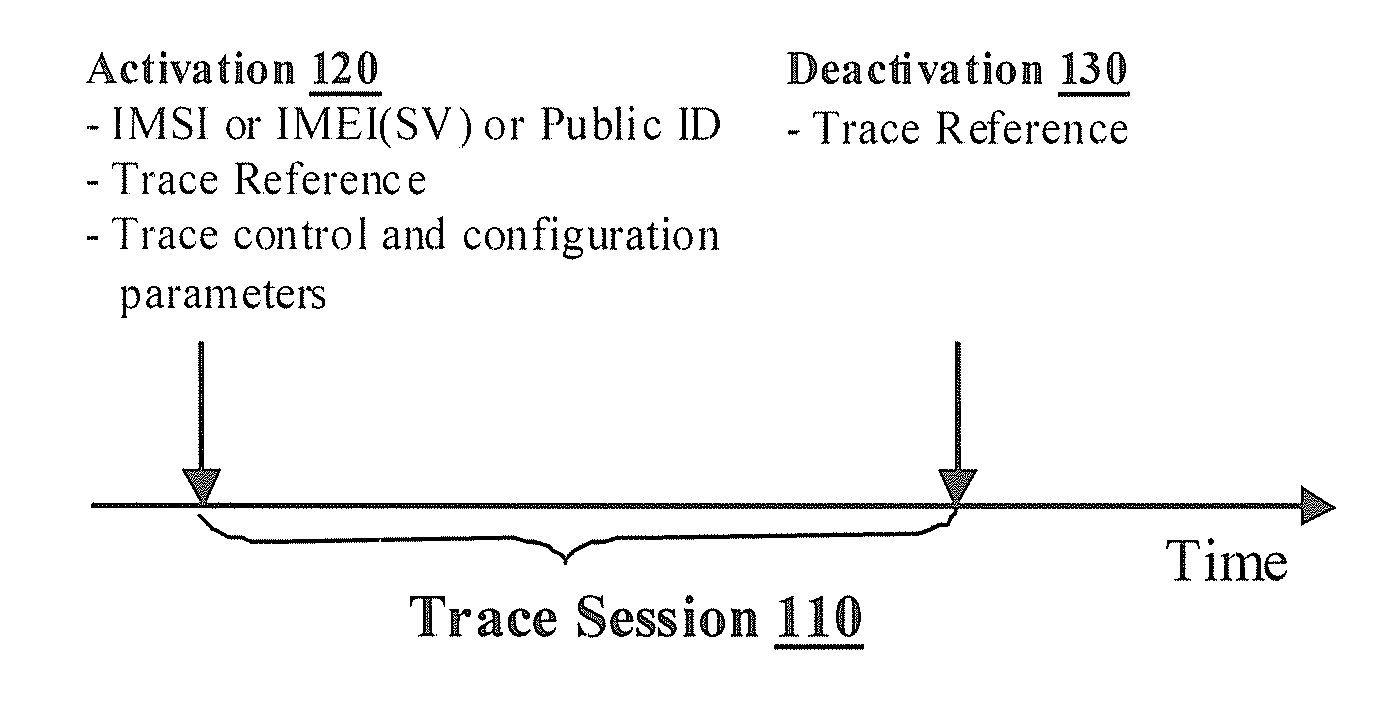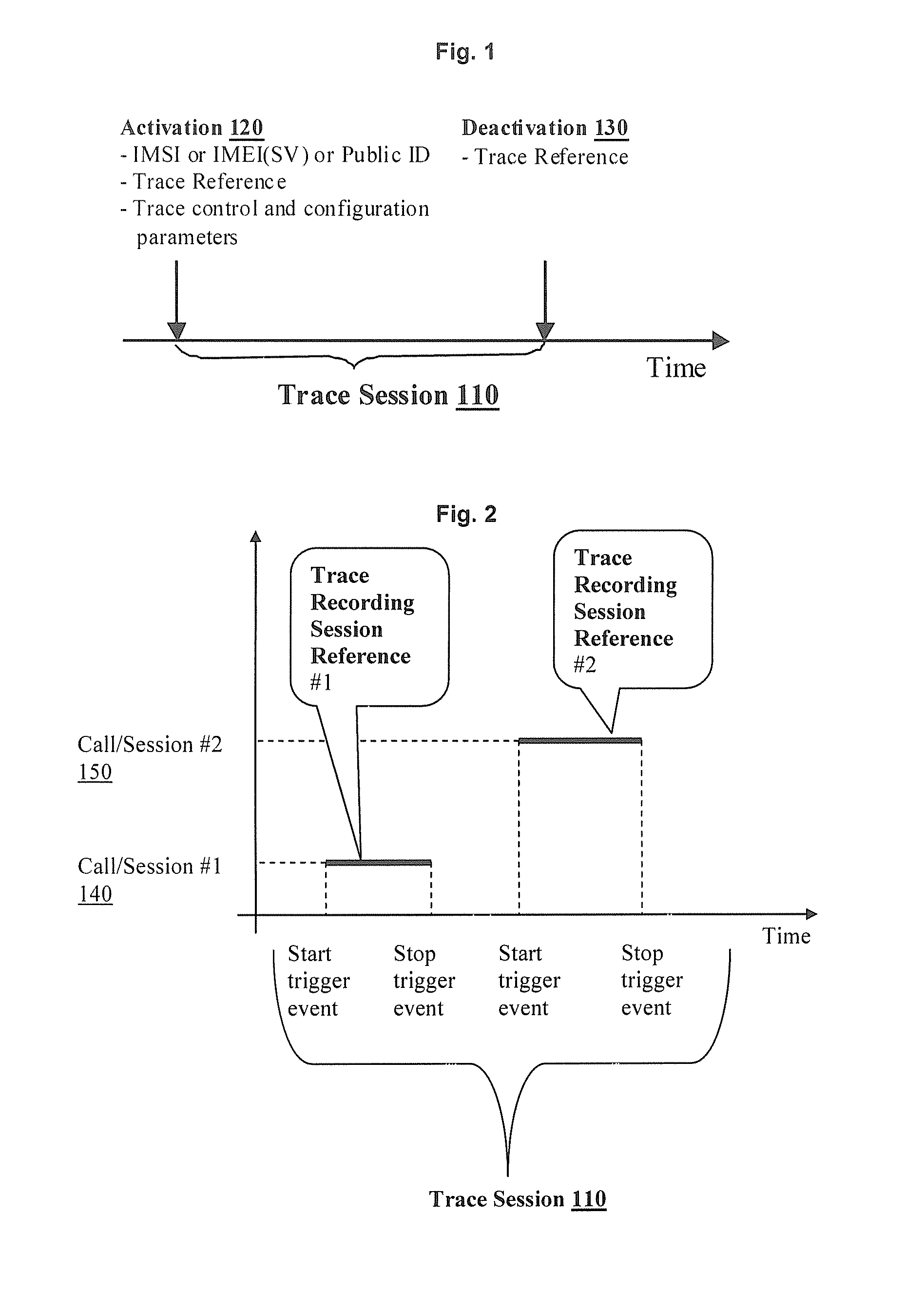Network Elements for End-to-End (E2E) Circuit Service (CS) Call Tracing Functionality
a network element and circuit service technology, applied in the field of wireless communication systems, can solve the problems of inconvenient operation, message traversing, and the inability to capture the center (tsc) of a call procedur
- Summary
- Abstract
- Description
- Claims
- Application Information
AI Technical Summary
Benefits of technology
Problems solved by technology
Method used
Image
Examples
first embodiment
The First Embodiment
[0104]FIG. 4 is a sequential timing diagram for illustrating the first embodiment of the present invention for an End-to-End (E2E) CS-CS call tracing scenario.
[0105]Referring to FIG. 4, in step 401, Operation and Maintenance (O&M) Service (such as EMS) sends Trace Session activation to HSS / Home Location Register (HLR).
[0106]In the present invention, the trace control and configuration parameters are extended to incorporate an E2E call tracing option to indicate whether this Trace Session is an E2E call Trace Session. If the E2E call tracing option is included (i.e., this Trace Session is an E2E call Trace Session), the trace control and configuration parameters are further extended to include a parameter of Trace Collection Entity to indicate a server to which all the trace data shall be sent. In the context of the present invention, what is described in detail is the case where the E2E call tracing option and the parameter of Trace Collection Entity are included...
second embodiment
The Second Embodiment
[0158]FIG. 5 is a sequential timing diagram for illustrating the second embodiment of the present invention for an End-to-End (E2E) CS-CS call tracing scenario. The steps of FIG. 5 which are the same as FIG. 4 are represented with the same reference numbers and thus the detailed descriptions thereof are omitted for avoiding redundancy.
[0159]After the steps 401-411 are performed, in step 512, GMSC includes the extension field of trace control and configuration parameters in the MAP (SRI) message when interrogating HSS to route the call.
[0160]In step 513, the interrogating HSS propagates the trace extension field to T-MSC in MAP PRN message if it supports the trace extension.
[0161]On the other hand, if the interrogating HSS does not support the trace extension field in the MAP SRI, it will not include the trace extension field in the MAP PRN message, then the steps 413-418 in the first embodiment will be performed instead of the processing sequence of steps 513, 5...
third embodiment
The Third Embodiment
[0176]FIG. 6 is a sequential timing diagram for illustrating the third embodiment of the present invention for an End-to-End (E2E) CS-IMS interworking call tracing scenario. The steps of FIG. 6 which are the same as FIG. 4 are represented with the same reference numbers and thus the detailed descriptions thereof are omitted for avoiding redundancy.
[0177]After the steps 401-409 are performed, in step 610, for CS-IMS interworking scenario, at the start of the trace recording session, the O-MSC includes a trace extension field in outgoing BICC / ISUP IAM message towards Media Gateway Control Function (MGCF) if the E2E call tracing option is included (i.e., set) for the corresponding trace session.
[0178]As an option, the O-MSC can decide whether to include the trace extension field in the outgoing BICC / ISUP IAM message or not based on the operator policy.
[0179]For example, the operator policy may be defined based on calling party number, called party number and / or rout...
PUM
 Login to view more
Login to view more Abstract
Description
Claims
Application Information
 Login to view more
Login to view more - R&D Engineer
- R&D Manager
- IP Professional
- Industry Leading Data Capabilities
- Powerful AI technology
- Patent DNA Extraction
Browse by: Latest US Patents, China's latest patents, Technical Efficacy Thesaurus, Application Domain, Technology Topic.
© 2024 PatSnap. All rights reserved.Legal|Privacy policy|Modern Slavery Act Transparency Statement|Sitemap



